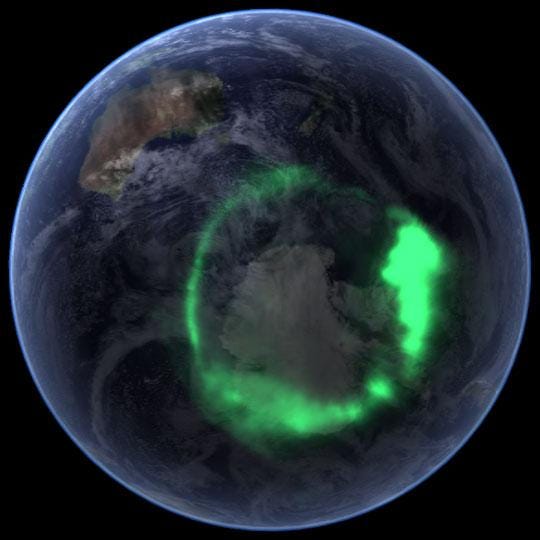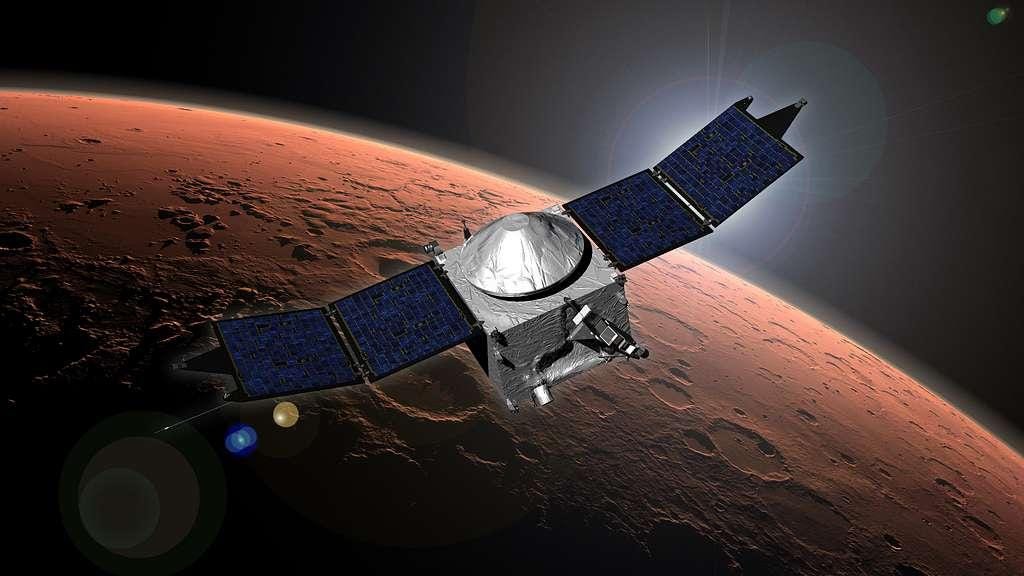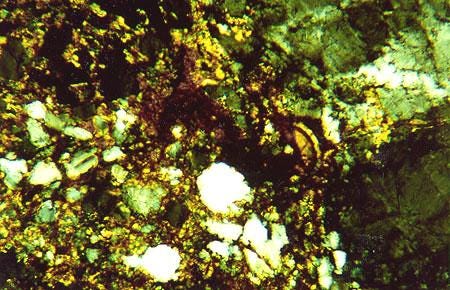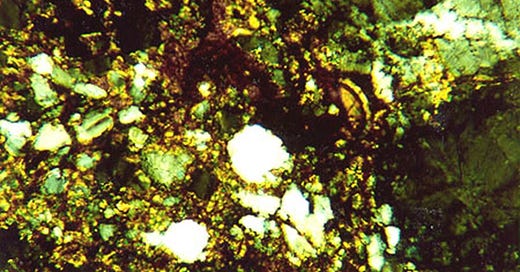ALH84001: Tiny Martian Time Machine
A trip to ancient Mars aboard the world's most famous meteorite
An audio version of this post is available on Substack and Spotify.
The Martian meteorite ALH84001 is best known for what it didn’t reveal—namely, conclusive evidence for biological activity on Mars. Yet this rock is far from done telling its story. ALH84001 holds some of the oldest available traces of the ancient Martian magnetic field, atmosphere, and hydrosphere. Since a planet needs these three elements to sustain life (as we know it), researchers are still looking to ALH84001 as they investigate the age-old question: could there be life on Mars?

Surfing the Magnetosphere
On dark polar nights, shimmering rivers of green and gold light flow through the darkness. The aurora is the most visible reminder that we live on a giant magnet. We see auroras when energetic charged particles from the Sun are captured by Earth’s magnetic field. The magnetic field tends to direct them toward the poles, where these particles interact with our atmosphere, releasing spectacular flares of energy. If you aren’t an aurora chaser, a GPS engineer, an astronaut, or a homing pigeon, you probably go through your day without a thought for Earth’s magnetism. Yet life on our planet would not exist without it.
Our magnetic field or magnetosphere arises from Earth’s geodynamo. As fluid metal churns in the Earth’s liquid outer core, its interaction with the existing magnetic field generates electrical currents that flow across the globe. The dynamo at the heart of our planet creates a kind of magnetized shield, fending off highly charged particles from the Sun or the reaches of deep space. This shield doesn’t just keep potentially deadly radiation from bombarding our bodies; it also holds the entire biosphere in place by defending one key piece: the atmosphere.

How would Earth look without its geodynamo? Just glance over at our neighbor, Mars.
Mars is smaller than Earth, and its low mass means that its liquid core exists at a lower pressure—and lower temperature—than Earth’s. At some point in the past, this cooler core appears to have become chemically stratified, slowing its fluid, dynamic churning. Eventually it stopped producing electrical currents altogether.
That’s when charged solar particles and cosmic rays set to work. These particles ionize the atoms and molecules of an atmosphere, imparting enough energy to send them hurtling away from the planet—and sometimes beyond the reach of its gravitational pull. Earth’s atmosphere is constantly “leaking” due to this process (among others), particularly where the magnetosphere is weaker. Thankfully, our atmosphere is sufficiently robust and well-protected to last a very long time.
Mars, however, never had a fighting chance. At roughly half the size of Earth, Mars was an easier target for the neighborhood bully: the Sun. Mars’s weaker gravitational pull meant that its atmosphere was less tightly bound to its surface, and once the planet’s dynamo stopped churning, atmospheric loss accelerated. Gas particles escaped into space, taking with them—in the form of water vapor—Martian lakes, rivers, and oceans. Had the planet been bigger, it might be Earth’s blue twin today, rather than our arid, reddish cousin.
It's a great story. But Mars is 150 million miles away and these events happened around four billion years ago. So how do we know any of this?

Noachian Mars (4.1 – 3.7 billion years ago)
To reconstruct ancient planetary history, scientists need access to magnetic signatures from a planet’s crust, isotopes of trapped atmospheric gases, and chemical evidence of interactions with water. On Earth, we find this information in ice cores, ocean sediments, groundwater, and other physical “time capsules.” When (or if) NASA’s extraordinary Mars Sample Return project brings Martian rocks back to Earth (something I wrote about here), we’ll have direct access to beautifully-preserved, several-billion-year-old Martian rocks, selected to be chemically and geographically representative. In the meantime, though, we have to make do with the rocks that have made it to Earth on their own.
Of these, none is so ancient and relatively pristine as ALH84001. For this meteorite, the stars aligned: it crystallized early in Mars’s history (around 4.09 billion years ago); it escaped recent, major shock impacts on Mars; and it landed in the cold, dry polar region of the Antarctic. Moreover, throughout its adventures—including three major impacts on Mars—it never got hot enough to destroy the magnetic and isotopic information stored within.
As Beard et al. wrote in a 2013 paper: “Martian meteorite ALH84001 remains our only direct sample of an early Martian terrane.”
Ten years later, this still holds true. In 2023, Steele et al. wrote of ALH84001: “Because it escaped late severe shocks on Mars and remagnetization on Earth, it is the most likely known sample to still host ancient magnetic remanence. The paleomagnetic record of ALH84001 may therefore be key to answering many of the remaining fundamental questions about the martian dynamo.”
Let’s travel back four billion years to wet, windy Noachian Mars in this tiny time machine.
Early in its history, Mars had quite a dense atmosphere: something we know, in part, thanks to ALH84001. The meteorite retains isotopic signatures of nitrogen and noble gases, including argon and xenon, which researchers have used to determine the composition and density (at least 0.5 bar) of the ancient Martian atmosphere. Temperatures were also milder: the carbonates in the meteorite apparently precipitated out of Martian water at around 18°C (~64.4°F), perhaps when a shallow aquifer washed over the rock.
The Martian atmosphere and liquid water were held in place by a global magnetic field, much like our own. And this is where ALH84001 really gets to shine.

In the 1990s, the magnetometer aboard the Mars Global Surveyor detected magnetic anomalies: signs that parts of Mars’s crust were still magnetized. And it turns out the brilliant display of polar lights is not restricted to Earth: Mars has its own patchy aurora. In other words, Mars is still magnetic. These findings raised all kinds of questions. Why do some areas retain magnetism while others don’t? Even more confusingly, some of the magnetized areas are very old (more than 4.1 billion years old) while other are more recent (around 3.9 billion years old). Yet there are non-magnetized regions that fall in between those dates. Were there two dynamos? Did the dynamo only operate in some regions of the planet?

Most significantly, the massive impact craters of Hellas, Isidis, and Argyre—created between 4.1 and 3.9 billion years ago—are only weakly magnetized. Had the early dynamo already died when these craters were gouged out of the Martian surface? Was it possible that, as one theory suggested, the monumental Hellas impact could have contributed to destroying the dynamo? Or did those impacts scoop out more highly-magnetized surface crust, leaving the weakly magnetized deeper crust behind?
In the last few years, studies of ALH84001 have brought the picture into focus. Using his state-of-the-earth Quantum Diamond Microscope (QDM), Dr. Roger Fu and his team of researchers at the Harvard Paleomagnetics Lab found notable magnetic traces in ALH84001 dating back 3.9 billion years. These traces have a strength of ~17 microtesla, around a third the average strength of Earth’s field, as a Science article notes.
For many years, it was assumed that the Martian dynamo had given up the ghost in the early Noachian, around the time of the Hellas impact. No longer. If the findings of Dr. Fu and his team hold, then the Martian dynamo persisted much later than previously believed. (That also means the “scooped out” theory may best explain the demagnetized impact basins.)
It’s hard to keep a planet habitable without a magnetosphere. If the Red Planet was globally magnetized for (at least) 200 million years longer than previously thought, that’s a lot more time for life to take root and thrive.

I was first introduced to ALH84001 a few years ago by Dr. Fu himself, in that same basement laboratory at Harvard. “This is probably the most studied rock in the world,” he said, showing me a thin black flake on a slide. “It’s beautiful, I think.” After three decades of intensive research, who would expect that this meteorite still held groundbreaking secrets? And yet, with new technology, new knowledge, and new scientific techniques, we are continuing to unravel its mysteries. As Dr. Fu wrote to me recently, “It was quite surprising to find so much complexity in a tiny little rock!”




Fascinating!